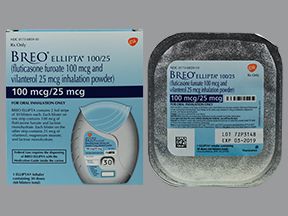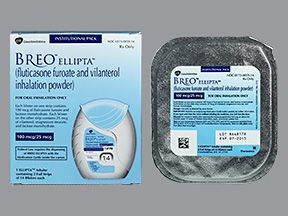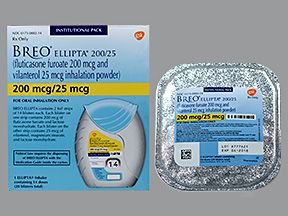The prescribed dosage for Breo Ellipta may depend on your individual treatment plan. Factors like your condition, medical history, age, and other treatments you take may affect your dosage of Breo Ellipta.
Breo Ellipta is a prescription drug used to treat chronic lung conditions. The drug comes as an inhaler that’s typically used once per day. Breo Ellipta specifically treats:
- asthma in adults and children ages 5 years and older
- chronic obstructive pulmonary disease (COPD) in adults
The active ingredients in Breo Ellipta are fluticasone furoate, which is a corticosteroid, and vilanterol, which is a long-acting beta2 agonist (LABA).
This article describes the dosages of Breo Ellipta, as well as its strengths and how to use it.
Below is common dosage information about Breo Ellipta.
Breo Ellipta form
Breo Ellipta comes as a gray and light blue plastic inhaler. The inhaler contains two foil strips with 30 blisters each. A blister is a compartment that contains a specific amount of the drug.
Breo Ellipta form strengths
Each foil strip of Breo Ellipta contains one of the active ingredients in powder form. The strengths are as follows:
- One strip contains 50 micrograms (mcg), 100 mcg, or 200 mcg of fluticasone furoate per blister.
- The other strip contains 25 mcg of vilanterol per blister.
A blister from each strip is used to create one dose.
You may see the strengths of Breo Ellipta referred to as 100/25 or 200/25, where the first number gives the fluticasone furoate strength and the second number is the strength of vilanterol.
The prescribed Breo Ellipta dosage may vary depending on the condition it’s being used to treat. The information below describes dosages that are commonly used or recommended. But be sure to take the dosage your doctor prescribes for you. Your doctor will determine the best dosage to fit your needs.
Dosage for asthma
The starting dosage for Breo Ellipta for asthma in adults is either:
- 100 mcg/25 mcg once per day or
- 200 mcg/25 mcg once per day
You’ll take one puff of your dose once per day. Your doctor will likely recommend taking your dose around the same time each day to help manage your asthma symptoms.
If you start treatment with the lower dose of 100 mcg/25 mcg, your doctor may increase it if your asthma doesn’t improve. They’ll prescribe the lowest dose that helps manage your symptoms. This is to help lower the risk of side effects from Breo Ellipta.
The maximum dosage of Breo Ellipta for asthma in adults is one puff of 200 mcg/25 mcg once per day.
Keep in mind, Breo Ellipta is not for immediate relief of asthma symptoms. For breathing problems that occur between daily doses of Breo Ellipta, your doctor will prescribe a short-acting rescue inhaler. An example of this type of treatment is albuterol (ProAir, Ventolin HFA).
Dosage for COPD
The dosage of Breo Ellipta for COPD is 100 mcg/25 mcg once per day. This is the maximum dosage of the drug for treating COPD. Your doctor will likely recommend taking your dose of Breo Ellipta at the same time daily. This will help manage your symptoms of COPD.
Some people may have shortness of breath that occurs between daily doses of Breo Ellipta. For immediate relief of this symptom, your doctor will prescribe a short-acting rescue inhaler, such as albuterol.
Breo Ellipta is used to treat asthma in children ages 5 years and older.
The dosage for children is based on the child’s age as follows:
- For children ages 5 to 11 years old, the recommended dosage is 50/25 mcg once per day.
- For children ages 12 to 17 years old, the recommended dosage is 100/25 mcg once per day.
For more information about Breo Ellipta’s dosage for children, talk with your child’s doctor or pharmacist.
Note: Breo Ellipta is not approved to treat COPD in children.
You take a dose of Breo Ellipta by inhaling it through your mouth and into your lungs. When you begin treatment, your doctor or pharmacist will show you how to use the Breo Ellipta inhaler to take your dose. You can also read the instructions for use.
Do not take two doses of Breo Ellipta at one time, even if you think you didn’t take your dose properly.
After you use your Breo Ellipta inhaler, be sure to rinse your mouth with water and spit without swallowing. This helps lower the risk of a side effect called oral thrush (a yeast infection in your mouth or throat).
If you have trouble using your Breo Ellipta inhaler, ask your doctor or pharmacist to show you how to use it correctly.
How long do you take Breo Ellipta?
Breo Ellipta is typically used as a long-term treatment. If you and your doctor determine that Breo Ellipta is safe and effective for you, it’s likely that you’ll use it long term.
What if I miss a dose?
If you miss a dose of Breo Ellipta, take it as soon as you remember. But do not take two doses of the drug to make up for missing a dose. This can increase your risk of side effects. Try to take your dose of Breo Ellipta at the same time every day.
If you need help remembering to take your dose of Breo Ellipta, try using a medication reminder. This can include setting an alarm or a timer, or downloading a reminder app on your phone.
Below are some common questions about Breo Ellipta dosage.
What happens if you take two doses of Breo Ellipta?
Taking two doses of Breo Ellipta can cause serious side effects, such as heart palpitations, high blood pressure, muscle cramps, shortness of breath, or headache. See the “What to do for Breo Ellipta overdose” section for more information.
It’s important to use Breo Ellipta exactly as your doctor prescribes. If you’re having trouble breathing between daily doses of Breo Ellipta, do not take an extra dose.
Instead, let your doctor know if you’re having breathing problems between Breo Ellipta doses. They’ll prescribe a rescue inhaler for managing immediate breathing problems.
How many doses of Breo Ellipta are there in an inhaler?
Each Breo Ellipta inhaler comes with a 30-day supply of the drug. Until you’re ready to take a dose of Breo Ellipta, do not open the inhaler. This might cause you to lose a dose of the drug.
Talk with your doctor or pharmacist if you have questions about the doses in your Breo Ellipta inhaler.
Will my dosage of Breo Ellipta be different if I have glaucoma?
Possibly. The manufacturer of Breo Ellipta hasn’t provided specific dosage recommendations for people with glaucoma.
But taking Breo Ellipta may increase your risk of glaucoma or other eye-related problems, such as cataracts. These eye-related problems have been reported in people taking inhaled corticosteroids, such as Breo Ellipta.
If you already have glaucoma or other serious eye conditions, your doctor will discuss whether Breo Ellipta is safe for you to use. If your doctor prescribes you Breo Ellipta, they may recommend that you visit an eye doctor to have your eyes checked before and during treatment.
Tell your doctor if you develop eye problems while using Breo Ellipta. In some cases, this drug may not be right for you.
Do not use more Breo Ellipta than your doctor prescribes. Using more than this can lead to serious side effects.
Some possible symptoms of overdose include:
- seizures
- increased heart rate
- hypercortisolism
- chest pain
- muscle cramps
- nausea
- dizziness
- shakiness
- dry mouth
- changes in blood pressure
- increased blood sugar level
- fatigue
What to do in case you use too much Breo Ellipta
Call your doctor right away if you think you’ve used too much Breo Ellipta. Depending on your symptoms, you may need monitoring for heart-related problems.
You can also call 800-222-1222 to reach America’s Poison Centers, or use its online resource. But if you have severe symptoms, call 911 (or your local emergency number) immediately or go to the nearest emergency room.
Disclaimer: Healthline has made every effort to make certain that all information is factually correct, comprehensive, and up to date. However, this article should not be used as a substitute for the knowledge and expertise of a licensed healthcare professional. You should always consult your doctor or another healthcare professional before taking any medication. The drug information contained herein is subject to change and is not intended to cover all possible uses, directions, precautions, warnings, drug interactions, allergic reactions, or adverse effects. The absence of warnings or other information for a given drug does not indicate that the drug or drug combination is safe, effective, or appropriate for all patients or all specific uses.








